By Jerad Jaborek
Michigan ranks fourth in total U.S. sugar beet production, producing 4,358,000 tons in 2020. The most recent October 2021 sugar beet production projections made by the USDA Economic Research Service estimates 4,758,000 tons of sugar beets to be produced in Michigan this year - a 9.17% increase from last year.
Recently, Michigan Sugar announced that they are instructing Michigan sugar beet producers to leave up to 5% of their sugar beet acres unharvested due to the anticipated record yield (36 tons per acre) of the 2021 sugar beet crop and an opportunity to participate in a voluntary buyback program for an additional 5,000 acres. With about 163,000 acres of sugar beets planted in 2021, this would result in 8,150 acres plus the 5,000 acres possible in the buyback program, for approximately 473,400 tons of unharvested sugar beets!
Instead of letting these sugar beets rot in the field, why not use them for cattle feed? Whole sugar beets have a high moisture (20-30% dry matter) and energy content (81% TDN; 0.60 NEg, Mcal/lb), but relatively low crude protein content (5-7%). Remember to have a feed analysis completed to determine the nutrient composition of your sugar beet crop before feeding. This year has been particularly wet and has likely altered the nutrient composition of the sugar beets to an extent (i.e., less sugar). Sugar beets can have a relatively high ash content depending on the amount of soil that remains attached, so washing may be necessary.

Pile of recently dug sugar beets (photo credit: Daniel Bublitz, MSU Extension Sugar beet Specialist)
Regardless, sugar beets offer an opportunity as an energy source in the diet of cattle. BEWARE, whole sugar beets must be processed to reduce their size and prevent choking by cattle. Processing sugar beets to reduce the size and possibility of choking can be done by running the sugar beets though a wood chipper or forage harvester. Sugar beets can also be driven over on concrete or allowed greater mixing times in some mixer wagons to process the sugar beets to a smaller size. After processing, sugar beets can be ensiled with chopped straw, or other dry ingredients, to produce sugar beet silage. Dry ingredients should be added with the chopped sugar beets to achieve the appropriate moisture content (~65%) needed for ensiling.
In a Journal of Agricultural Studies paper from McGregor and others, a 50-day beef steer growing trial used chopped sugar beets to replace rolled barley at 0, 15, 30, or 40% of the diet on a dry matter basis. The four diets varied significantly in dry matter percentage (87.4, 74.9, 64.7, 57.3%) due to the substantial moisture in the sugar beets. Average daily gain and feed efficiency were similar. As-fed feed intake increased linearly with the addition of more sugar beets (18.0, 22.6, 25.8, 27.9 pounds per day). However, on a dry matter basis, feed intake was greater for the 15 and 30% sugar beet inclusion rates (16.9 and 16.7 pounds per day) versus zero and 45% (15.7 and 16.0 pounds per day).
The addition of sugar beets may have increased diet palatability and dry matter intake at 15 and 30% sugar beet inclusion levels; however, the greater moisture content of the diet with a greater inclusion of sugar beets at 45% may have caused physical limitations on how much dry matter they could consume. Therefore, chopped sugar beets showed that they can be supplied up to 20 to 30% of the diet without negative consequences on feedlot cattle performance.
Wilke and others published a study in Applied Animal Science where they ensiled sugar beets with straw and offered this beet silage to gestating beef cows, growing crossbred beef steers, and finishing crossbred beef steers. Replacing dry rolled corn with 20% beet silage resulted in no differences in body weight or body condition score change for cows. Feeding sugar beet silage (72% sugar beets and 28% straw) at 61% of the diet compared with corn (39%) and straw (17%) to growing crossbred beef steers resulted in a reduced dry matter intake, but a slight improvement in feed efficiency.
During the finishing phase, replacing corn and straw with sugar beet silage at 21 and 42% reduced average daily gain, feed efficiency and carcass fat deposition (back fat and marbling), but increased dry matter feed intake. A possible explanation for the reduction in performance and carcass fat deposition with sugar beet silage inclusion could be due to how the diets were formulated. The 21 and 42% sugar beet silage diets offered during the finishing phase had a greater neutral detergent fiber concentration (28 and 37%) when compared with the control corn and straw diet (22%).
A greater fiber content likely reduced diet digestibility and contributed to the reduction in available energy to be used for body weight gain and fat deposition. This research has demonstrated that careful evaluation is needed when formulating diets to ensure cattle are receiving the correct level of nutrients (e.g., energy, protein) for the desired feedlot performance. Sugar beet silage has shown that it can be another useful feedstuff using sugar beets in diets for cattle in different production stages.
Before you consider feeding sugar beets to your cattle you should consider how the price of sugar beets compares with other feedstuffs that you may replace them with in the diet. The Michigan State University Extension beef team has a resource that demonstrates how to calculate the value of sugar beets on an energy basis compared with corn.
Carefully consider the cost of transporting sugar beets to your farming operation. Remember, sugar beets are 70-80% water, which may make procuring and feeding sugar beets cost prohibitive for those cattle operations further from a sugar beet source. Overall, the excess sugar beets available due to the record sugar beet crop in Michigan offer an excellent opportunity for cattle producers to utilize another feedstuff to design cost effective diets for more efficient beef production.
Source : msu.edu